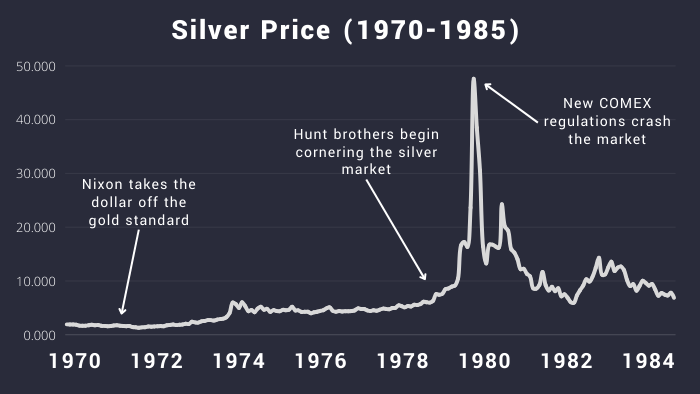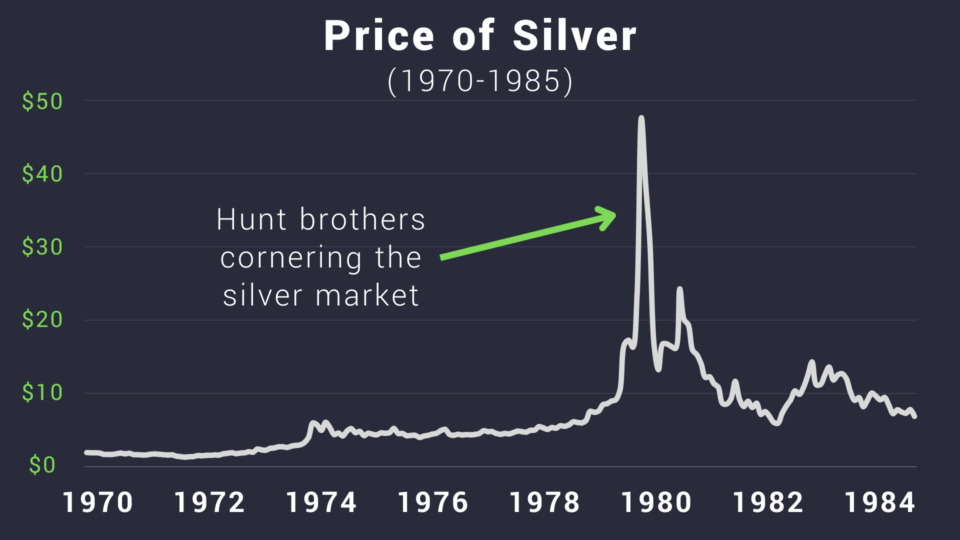The price of silver is determined by supply and demand on major exchanges, as traders react to inflation expectations, interest rates, industrial demand, and geopolitical events.
For millennia, humans have tracked the price of silver to craft coins, jewelry, and decorative items.
These days, we demand the “white metal” for the production of semiconductor chips, touch screens, solar panels, RFID chips, and medical devices, making the silver price more relevant than ever.
What is the silver spot price?
The definition of “silver spot price” is the price that an investor will pay for the immediate delivery of one ounce of silver. The transaction happens “on the spot,” hence the name.
When someone says “the silver spot price,” it gives the impression that there is a single, authoritative spot price of silver. But this is not the case. The “spot price” is a theoretical estimate of the real-time market value of silver. It is not published by any government or official entity. Rather, individual exchanges and brokerage firms find a close approximation using different benchmarks (see below).
Retail investors cannot purchase silver at the “spot price” because dealers always charge a premium or commission over spot. When making a purchase, investors pay the spot price plus the premium.
How is the silver spot price determined?
There is no centralized price for silver. When quoting a “spot price,” dealers and exchanges typically use a combination of reference sources, such as:
The NYMEX continuous contract price
The New York Mercantile Exchange (NYMEX) is the world’s largest commodities futures exchange.
A “futures contract” is an agreement to buy or sell a specific quantity of silver in the future for a specific price. Futures contracts allow companies or investors to lock in a price today for a product that will be delivered tomorrow.
Because each contract expires on a specific date, it is difficult to provide a continuous, long-term price of silver without the gaps and interruptions caused by contract expirations. The “continuous contract price” solves this problem by linking the prices of successive futures contracts to create a single, uninterrupted price chart. The composite price provides an accurate real-time benchmark.
The LBMA silver price
The London Bullion Market Association (LBMA) is an international trade association that represents the global over-the-counter (OTC) market for gold and silver bullion.
The LBMA Silver Price (or Daily Auction Silver Price) is a global benchmark for silver, determined through an electronic auction. The auction is conducted every day at 12:00 noon London time. During the auction, banks, bullion dealers, refiners, institutional investors, and other market participants submit buy and sell orders for silver. The system calculates a clearing price that matches the highest number of buy and sell orders.
Silver ETF prices
Large silver-backed exchange-traded funds also serve as accurate benchmarks for the market price of silver. The largest such ETF is iShares Silver Trust, also known as SLV.
Prices from silver wholesalers
Silver refiners and wholesalers often quote their own spot price, which can be used as a benchmark. The world’s largest silver wholesalers include Metalor, PAMP, and Argor-Heraeus in Switzerland, Asahi and Elemetal in the US, and the Royal Canadian Mint in Canada.
Silver prices change every day. View the current silver price here.
What drives the price of silver up or down?
The price of silver, like the price of any asset, is determined by individual buyers reaching agreements with individual sellers. It fluctuates constantly throughout the trading day.
In a liquid market with many buyers and sellers, we get the impression of a smooth, continuous, unified price. But it is important to remember that the prevailing price in any market (silver included) is always the result of many individual transactions between marginal buyers and sellers. When we speak about “factors that influence the price of silver,” we really mean factors that encourage individual buyers to accept a higher price for silver (or demand a lower one), or factors that encourage individual sellers to demand a higher price for silver (or accept a lower one).
The factors listed below do not have a direct causal link to the price of silver, but they do influence how individual market participants appraise the value of silver, and therefore influence what kind of agreements buyers and sellers will reach in the marketplace.
Here are 10 key factors that influence the price of silver:
#1: Industrial Demand
Silver is the world’s most conductive and reflective metal, making it critical for electronics, solar panels, and electric vehicles. Its antimicrobial properties also make it valuable for medical equipment.
The industrial uses of silver guarantee a constant source of demand.
According to the Silver Institute, industrial fabrication is expected to surpass 700 million oz in 2025. The industries of the future (AI, renewable energy, advanced electronics) will sustain silver prices for decades to come.
Strong economic growth tends to increase industrial demand for silver. Economic downturns can reduce industrial activity and silver demand.
#2: Gold Prices
Gold and silver move together because they are both monetary metals. They both serve as stores of wealth and hedges against currency devaluation. Rising demand for gold typically spills over into silver. Silver is more volatile because it has a smaller market.
Many precious metals investors use the gold/silver ratio to guide their silver purchases. The gold/silver ratio is the gold price divided by the silver price. For example, if gold is $3,000/oz and silver is $40/oz, the ratio is 75.
If the ratio is high (90–100), it suggests silver is cheap relative to gold. Traders buy silver and/or sell gold, expecting the ratio to return to historical norms as silver “catches up.”
If the ratio is low (40–50), it suggests silver is expensive relative to gold. Traders sell silver and/or buy gold, expecting the ratio to rise.
#3: Interest rates
When interest rates fall, silver tends to rise. The reason is because silver does not pay interest (like bonds and some other assets). As interest rates rise, silver demand falls because the opportunity cost of holding non-yielding assets rises. Lower interest rates make silver more attractive, while higher rates make bonds and savings accounts more attractive.
Lower interest rates also correlate with a larger money supply. The more money bouncing around the system, the higher the silver price.
This chart shows the rough inverse relationship between the price of silver and the 10-year treasury yield, a benchmark interest rate:
#4: Inflation expectations
Silver is seen as a hedge against inflation and currency devaluation. High inflation rates and weakening currency can drive investors to buy silver, increasing its price.
Because silver’s supply is limited (and it requires time and energy to dig out of the ground), silver tends to retain its purchasing power much better than fiat currencies. The more dollars are printed, the higher the ceiling on silver’s price.
#5: Monetary policy
Central bank policies have a direct impact on silver prices. Policies that lead to currency devaluation tend to boost silver demand.
- In 1971, President Nixon took the US dollar off the gold standard. In the following decade, the price of silver skyrocketed from $1.60/oz to a peak of $48/oz.
- When the pandemic hit the US in the beginning of March 2020, the price of silver dropped 37% in just four weeks. When the US government started printing money to prop up the economy, silver’s price skyrocketed by over 140%. Investors feared that loose monetary policy would cause runaway inflation.
#6: Regulatory changes
Changes in mining regulations, environmental policies, and trade policies can affect silver production and trade.
The General Mining Act of 1872 allows for gold, silver, copper and other metals to be mined from federal lands at low lease prices and without paying back royalties. It was passed during the pick-and-shovels time of the early gold rush era. Congress has attempted to increase the cost of leasing land and introducing mandatory royalties that benefit taxpayers. New regulations that make mining more expensive could reduce supply and increase the price of silver.
In the late 1970s, the Hunt brothers attempted to corner the silver market by buying up massive quantities of silver and taking delivery. To prevent this, the COMEX increased margin requirements and capped the number of contracts any single entity could hold. As the regulatory measures took effect, investors lost confidence and began selling off their silver holdings, leading to a rapid decline in prices. The Hunt brothers were forced to liquidate their positions at significant losses, plunging the silver price to $5.50 by mid-1982.

#7: Market sentiment
Because the silver market is relatively small (compared to gold), futures positioning and ETF inflows or outflows can lead to exaggerated price movements. Sentiment acts as an amplifier, making silver prices more volatile in response to news and investor expectations, regardless of underlying supply and demand fundamentals.
#8: Speculative positioning in the futures market
Companies use futures contracts to stabilize their cost of raw materials. For example, imagine a company needs 100,000 ounces of silver to manufacture solar panels. They enter a futures contract to lock in a price of $30/oz for the next month. No matter what happens to the market price, the company will be able to acquire the silver next month for $30/oz.
Hedge funds and other speculative traders also trade futures. They go “short” or “long” in the futures market (aka bet that the price of silver will fall or rise) to make money.
If there is a huge amount of net short positioning, meaning many market participants are betting on the price to fall, this can actually be a bullish signal because it indicates that the market is running out of selling pressure. To go short, speculators sell assets they do not currently own, with the expectation that they can buy them back at a lower price in the future. If the price begins to rise instead, they have to quickly buy the asset back so they don’t lose money (a “short squeeze” dynamic).
#9: Silver scrap
Before the growth of digital photography, silver was a popular element in film photography due to its ability to reflect light. As film photography declined, film became a large source of scrap silver.
Silver scrap can also come from old coins, jewelry and silverware. When silver hits a huge price spike (like it did during the 1970s and again in 2011) people are encouraged to melt down and repurpose silver scrap. This increases supply and stabilizes the silver price.
#10: Cost to mine silver
The cost to mine silver sets a practical floor under its price. If silver prices fall below the average cost of production, mining becomes unprofitable and miners reduce output or shut down operations. Falling supply eventually boosts prices, bringing them back above production costs. On the other hand, when silver prices rise well above mining costs, miners increase production and invest in new projects, gradually increasing supply.
25–30% of global silver production comes from primary silver mines, where silver is the main product. These mines extract high-grade ore, which is crushed, ground, and refined to isolate silver.
70–75% of silver is produced as a byproduct of mining other metals like lead, zinc, copper, and gold. In these operations, silver is recovered during smelting or refining of the primary metals.
Because most silver is mined as a byproduct of other metals, prices can remain below marginal silver production costs for extended periods of time. Supply does not quickly adjust to price changes, making silver prices more sensitive to demand shifts.
When is the best time to buy silver?
The best time to buy silver is when it is undervalued against other assets.
Right now, silver is historically undervalued against gold, the stock market, and the total money supply. Growing industrial applications in renewable energy and medical technology means the price of silver will need to rise to meet demand.
Vaulted is the easiest way to own silver
With just a few taps, you can own any amount of physical silver. It takes 30 seconds to set up your free Vaulted account.
Once you transfer funds, you can instantly buy real silver. You will own segregated, serial-numbered bars.











